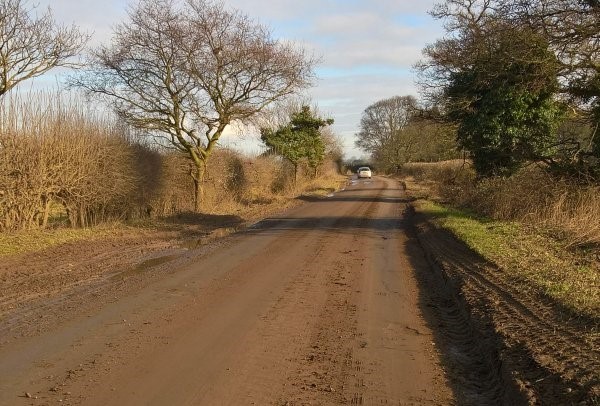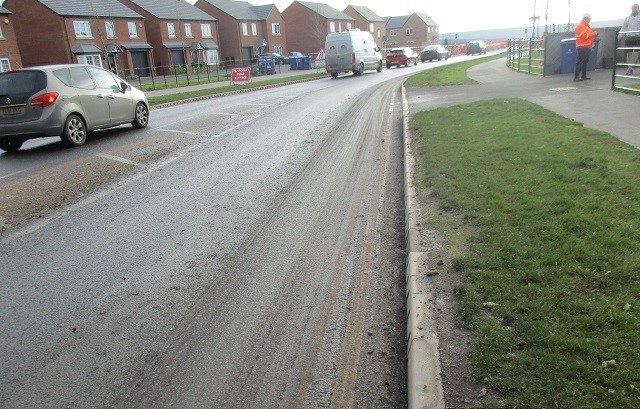Mud on Road Guidance
These guidance notes refer to instances where an owner/occupier or contractor of land or property adjacent to a highway deposits soil, mud or other debris upon a highway. The definition of a public highway includes footways, footpaths and adjacent verges, bridleways as well as the road itself whether adopted or not.
What offence am I committing if I deposit mud or other debris on the highway?
Section 148 of The Highways Act 1980 states; “If, without lawful authority or excuse, a person deposits anything whatsoever on a highway to the interruption of any user of the highway he/she is guilty of an offence.”
In addition, section 161 of the Highways Act 1980, makes it an offence for anyone to deposit anything on a highway without lawful authority or excuse, which leads to a highway user being injured or endangered, or to allow filth, dirt or other offensive material to flow or run from adjacent land onto the highway. Section 151 of the HA 1980 enables the Council to serve a notice giving the owner/occupier of land adjacent to a street.
Objectives
To assist in the statutory duty of the Highway Authority to keep the Highway clear and safe for all highway users.
To remove deposits from the Highway that may constitute a road safety hazard for highway users – in particular, mud is considered to be a danger to users of the highway because it may cause loss of control and skidding and lead to accidents. This can be accelerated in adverse weather conditions especially for cyclists / motorcyclists.
To minimise disruption to nearby residents by ensuring developers, others and businesses abide by the relevant legislation.
Prevent blocking of street gullies and subsequent flooding.
To seek an improvement in the visual street scene by the prevention and reduction of unsightly debris illegally deposited on the Highway.
To reduce the need to take legal action against those guilty of depositing debris on the highway.
The law
Vehicle operators, contractors, others and farmers who deposit mud on the road are potentially liable for a range of offences. This guidance note is not a complete statement of the law or of your responsibilities and possible liabilities.
A range of powers are available to the Police and the Highways Department, primarily the Highways Act 1980; and the Road Traffic Act 1988.
Highways Act 1980 Section 137 states “If a person, without lawful authority or excuse, in any way wilfully obstructs the free passage along a highway he is guilty of an offence”. Highways Act 1980 Section 148 “If without lawful authority or excuse a person deposits anything whatsoever on a highway to the interruption of any user of the highway he is guilty of an offence” Highways Act 1980.
Section 149 of the Highways Act states “if anything is deposited on the highway so as to constitute a nuisance/danger the Highway Authority can require the person who put it there to remove it forthwith”. Mud causes skidding, loss of traction and is therefore dangerous and a nuisance.
Highways Act 1980 Section 161 states “If a person, without lawful authority or excuse, deposits anything whatsoever on a highway in consequence of which a user of the highway is injured or endangered, that person is guilty of an offence”. Furthermore, the Road Traffic Act 1988 covers situations where a mechanically propelled vehicle is driven dangerously on a road. Driving dangerously can include driving a vehicle in a state that could cause danger to others.
Punishment for these offences ranges from fines to imprisonment.
Consequences and failure to comply
The Council operates a zero tolerance policy for mud/debris being deposited on the highway due to the safety hazard it creates and also the nuisance and anti-social aspects of this practice on the local amenity and the traveling public. There is also a significant increased risk of a road traffic collision occurring which could lead to a fatality. It is also resource intensive for Doncaster Council to have deploy on of its own mechanical sweepers to cleanse the highway.
Highway Network Management officers will collate all information and evidence in order to assist with the recovery of costs and advise the person or persons responsible for deposits on the highway that the Council will be recovering the costs incurred as a result of cleansing the highway. Doncaster Council will use the most appropriate and effective powers at its disposal to swiftly deal with such issues. The Council will use its powers under the HA 1980 and TCPA 1990, either individually or as a combination of the two where appropriate. The safety of highway users is of paramount concern to the Council and this will be the primary consideration when making decisions as to what action should be taken in any given case.
Civil action
Civil action can occur where the presence of mud results in personal injury, damage to property, loss or inconvenience. The presence of mud can constitute a public nuisance and loss or injury can result in a claim for negligence.
What you should do
- Be prepared to hire in equipment necessary to be able to remove mud or other deposits prior to any vehicle using an adopted highway and also have a contingency control measure in place should your initial control measure fail. Should both fail then you should consider suspending vehicle movements.
- Be prepared to keep a written record of your decisions on whether or not to deploy signs.
- Keep to low speeds – especially when travelling a short distance – to help retain mud on the vehicle.
- Keep to your own farm roads and minor roads whenever possible.
What you must do
Do everything possible to prevent mud being deposited on the road. This includes cleaning mud from vehicles before they are taken onto the road. The fact that the cleaning of mud off vehicles, tractors and their attachments is commercially inconvenient is not a defence.
Comply with all Planning Conditions imposed on the site where applicable, including the first 15 metres of road leading off the Highway should be surfaced and that the provision of adequate on-site wheel washing equipment be installed as appropriate and should be in compliance with any Construction Traffic Management Plan.
Only use signs that are authorised. The recommended sign shows 'Slippery Road' triangle with 'Mud on the Road' sub plate. If appropriate, the 'Men at Work' sign should be used. Make sure they are positioned to give maximum visibility and warning to other road users.
Health and Safety
Under the Health & Safety at Work Act 1974, employers have a duty to look after the health and safety, not only of themselves, their family and employees, but of anyone who may be affected by their working operations. Employees also have the responsibility to themselves and others.
Recovery of clean-up costs by Highways Authority – City of Doncaster Council
City of Doncaster Council, as the Highway Authority, has a duty to assert and protect the rights of road users. Section 149 of the Highways Act 1980 gives the Highways Authority the power to clean the road and recover its expenses from the person causing the obstruction/nuisance.
Can I use a mechanical sweeper on the highway?
City of Doncaster Council do not allow third party mechanical sweepers on any part of our adopted network. The reason for this is that during inclement weather when grit is applied any use of a third party sweeper will remove this and potentially create a hazard for highway users.
The only occasion that we would allow for a ‘one off sweep’ would be if all other control and contingency measures had failed and as such we would require contact to be made directly to Highways Network Management via Customer Services 01302 736000 Network.Management@doncaster.gov.uk
Third parties cleansing the highway should not become common practice and not as part of general control measures. However if done the highway operatives carrying out the cleanse should be accredited to work on the highway and be wearing suitable PPE, temporary traffic management (if required) should be in place in the form of advanced temporary warning signage informing motorists of the presence of mud on the highway and advanced warning of cleansing operations taking place in line with Chapter 8 (operations) of the Traffic Signs Manual (2009). Vehicles should be suitably marked and meet the conspicuity requirements in terms of vehicle markings and lighting beacons in accordance with Chapter 8 of the Traffic Signs manual 2009.Third party cleansing can be allowed if it helps deal with a one-off situation efficiently , safely and expediently.
Further information
Agricultural farmers can also find additional information from the NFU (National Farmers Union) website.
Report a mud spillage on the road
Downloads & Resources
- Highways Mud On Road Flyer
- Download (1021KB - PDF)
Display your introduction over featured image?: No


